
Motorenwerke Zschopau GmbH is a German motorcycle manufacturer located in Zschopau, Saxony. The acronym MZ since 1956 stands for Motorenwerke Zschopau GmbH. From 1992 to 1999 the company was called MuZ, an acronym for Motorrad und Zweiradwerk.

Syarikat Motosikal dan Enjin Nasional Sdn. Bhd, or known as Modenas for short is a Malaysian national motorcycle company producing various small motorcycle models below 400cc targeted for local market and export. The company's headquarters and factory are located at the small town of Gurun, Kedah, Malaysia.
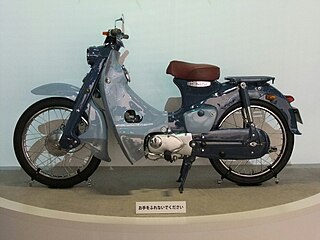
The Honda Super Cub or Honda Cub is a Honda underbone motorcycle with a four-stroke single-cylinder engine ranging in displacement from 49 to 124 cc.
Kawasaki Motors Philippines Corporation is a subsidiary of Kawasaki Heavy Industries, Ltd. under the Motorcycle and Engine division. It manufactures motorcycle/motorcycle parts, and bicycle/bicycle parts.

The Malaysian Cub Prix Championship is a national-level underbone or moped racing series for motorcycles with displacements from 100 to 150cc. The tournament is a grassroots developer with the main objective of discovering and developing Malaysian motorcycle racing talents.
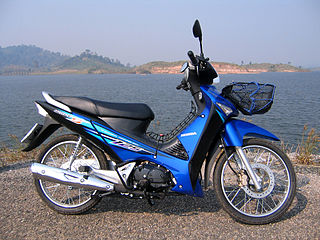
The Honda Wave – also marketed as the Honda NF series (codename), Honda Innova in Europe, and Honda Supra in Indonesia – are a series of motorcycles manufactured by Honda that debuted in 1995 with an underbone design, having separate cosmetic plastic body panels over a structural steel tube chassis. The Wave series succeeds the Super Cub which used pressed steel frame acting as both the structural chassis and cosmetic bodywork. It serves as the Southeast Asian model of the historic Honda Cub.

The Bajaj CT 100 is a 100 cc commuter motorcycle built by Bajaj Auto. It is the entry level commuter motorcycle offered by Bajaj Auto.
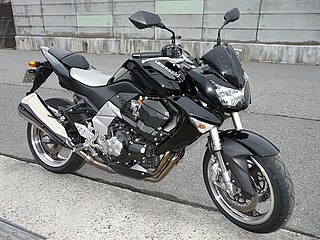
The Kawasaki Z1000 is a four-cylinder motorcycle introduced in 2003 with streetfighter or standard styling. The Z1000 was first introduced in 1977 superseding the previous 903 cc capacity Z1/Z900.

The Kawasaki triples were a range of 250 to 750 cc motorcycles made by Kawasaki from 1968 to 1980. The engines were air-cooled, three-cylinder, piston-controlled inlet port two-strokes with two exhaust pipes exiting on the right side of the bike, and one on the left. It was the first production street motorcycle with capacitor discharge ignition (CDI). Right from the first triple model, the 1968 Mach III H1 500 cc, it was a sales success that gained a reputation for almost unmatched acceleration as well as an air of danger for inexperienced riders trying to cope with the bike's increased power to weight ratio over any previously available stock motorcycles.

An underbone is a type of motorcycle that uses structural tube framing with an overlay of plastic or non-structural body panels and contrasts with monocoque or unibody designs where pressed steel serves both as the vehicle's structure and bodywork. Outside Asia, the term underbone is commonly misunderstood to refer to any lightweight motorcycle that uses the construction type, known colloquially as step-throughs, mopeds or scooters.
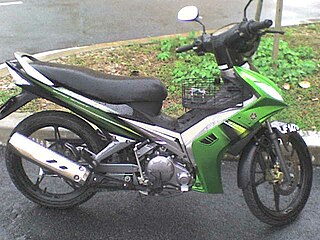
The Yamaha T135 is an underbone manufactured by Yamaha Motor Company since 2005. It is known as the Spark 135/135i in Thailand, Sniper/MX 135 in the Philippines, Jupiter MX 135 LC in Indonesia, 135LC in Malaysia, Exciter 135 in Vietnam, and Crypton X 135 in Greece. It is powered by a 134.4 cc (8.20 cu in) single-cylinder engine.

The Kawasaki Z1 is a four-cylinder, air-cooled, double-overhead camshaft, carbureted, chain-drive motorcycle introduced in 1972 by Kawasaki. Following the introduction of Honda's CB750 in 1968, the Z1 helped popularize the in-line, across-the-frame four-cylinder, a format that became known as the Universal Japanese Motorcycle or UJM.
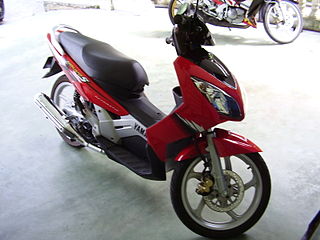
The Yamaha Nouvo is a CVT underbone manufactured by Yamaha Motor. It was introduced in April 2002 for Southeast Asia markets and In 2004, Brazil, where it was renamed the Yamaha Neo. Nouvo is from the French word Nouveau, which means new or fashionable.

Yamaha Lagenda is a series of underbone motorcycle produced by Yamaha for the Southeast Asian market. It was introduced for the 2000 model year replacing the SRX 100. A more performance-oriented version of the Lagenda is marketed as ZR.

A scooter is a motorcycle with an underbone or step-through frame, a seat, and a platform for the rider's feet, emphasizing comfort and fuel economy. Elements of scooter design were present in some of the earliest motorcycles, and motor scooters have been made since at least 1914.

Modenas CT series is a series of underbone motorcycles produced by Malaysian motorcycle manufacturer, Modenas. The CT were first launched in 2009 as a legitimate successor of the popular Modenas Kriss series. Before the CT was developed, another underbone model known as Modenas Kristar was produced in 2004 but the production ended two years later due to lack of appeal. The 100 cc and 110 cc engines derived from the Kriss series remain unchanged, but with the addition of a decompression mechanism for the 110 cc model to ease starting.

The Suzuki FX125 is an underbone motorcycle manufactured in Malaysia from 1998 and it is one of the most powerful 4 stroke engines.

Meguro motorcycles were built by Meguro Manufacturing Co motorcycle works (目黒製作所), founded by Hobuji Murato and a high-ranking naval officer, Takaji Suzuki, in 1937. One of the first Japanese motorcycle companies, it became a partner of Kawasaki Heavy Industries Ltd, and was eventually absorbed. Named after a district of Tokyo, Meguro had its roots in Murato Iron Works, which was established in 1924. Meguro Seisakusho, which had once developed a copy of a Harley-Davidson V-twin, was established to design and build gearboxes for the nascent Japanese motorcycle industry. Abe Industries, which had once produced its own motorcycle, merged with Meguro in 1931. The brand is being revived by Kawasaki with a new K3 model to be introduced in Japan on February 1, 2021.
The Kawasaki Barako is a motorcycle model built by Kawasaki Motors Philippines. Launched in 2004, the Kawasaki Barako was designed to replace the older two-stroke Kawasaki HD-III which was launched back in 1982 and it continued production due to its maintenance simplicity, raw power, and popularity among tricyclists. unitil the HD-III was phased out in 2007, the BC 175 is primarily used as utility hauler for business needs. Its primary competitors include the Honda TMX series, the Yahama RS110F and Kawasaki's own CT series of motorcycles.
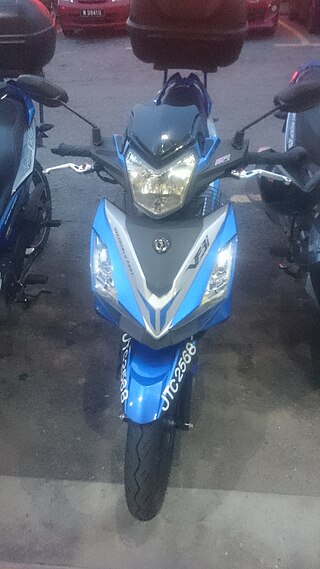
The SYM VF3i 185 is a fuel-injected underbone motorcycle model by Taiwanese motorcycle company SYM Motors. The SYM VF3i is currently the largest-engined underbone motorcycle in the world, powered by a 183 cc SOHC 4-valve water-cooled engine. It was debuted in Malaysia on 5 April 2018 before being sold in Vietnam later in December. In Vietnam, however, the VF3i is given a smaller 174.5 cc engine and is sold as the SYM Star SR 170. 31hp


















